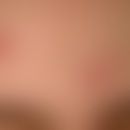DefinitionThis section has been translated automatically.
In molecular biology, a RING finger domain (RING stands for: Really Interesting New Gene) is a "zinc finger" type protein structural domain containing a C3HC4 amino acid motif that binds two zinc cations (seven cysteines and one histidine arranged in a non-consecutive manner). This protein domain contains 40 to 60 amino acids. Many proteins containing a RING finger play a key role in the ubiquitination pathway.
General informationThis section has been translated automatically.
Zinc finger domains (Znf) are relatively small protein motifs that bind one or more zinc atoms and usually contain multiple finger-like protrusions that make tandem contacts with their target molecule. They bind DNA, RNA, protein and/or lipid substrates. Their binding properties depend on the amino acid sequence of the finger domains and the linker between the fingers, as well as the higher order structures and the number of fingers.
Zinc finger domains often occur in clusters in which the fingers may have different binding specificities.
A number of superfamilies with Znf motifs are known to differ in both order and structure. They show considerable versatility in binding modes, even among members of the same class (e.g., some bind to DNA, others to proteins), suggesting that Znf motifs are stable scaffolds that have evolved specialized functions. For example, Znf-containing proteins function in gene transcription, translation, mRNA transport, cytoskeletal organization, epithelial development, cell adhesion, protein folding, chromatin remodeling, and zinc recognition. Zinc-binding motifs are stable structures and rarely undergo conformational changes upon binding to their target.
Many RING finger domains simultaneously bind ubiquitination enzymes and their substrates and therefore function as ligases. Ubiquitination, in turn, targets the substrate protein for degradation. The RING finger domain has the consensus sequence C-X2-C-X[9-39]-C-X[1-3]-H-X[2-3]-C-X2-C-X[4-48]-C-X2-C.
C is a conserved cysteine residue involved in zinc coordination.
H is a conserved histidine involved in zinc coordination, Zn is a zinc atom, and X is any amino acid residue.
Note(s)This section has been translated automatically.
Examples of genes containing a fing finger domain:
AMFR, BARD1, BBAP, BFAR, BIRC2, BIRC3, BIRC7, BIRC8, BMI1, BRAP, BRCA1, CBL, CBLB, CBLC, CBLL1, CHFR, CNOT4, COMMD3, DTX1, DTX2, DTX3, DTX3L, DTX4, DZIP3, HCGV, HLTF, HOIL-1, IRF2BP2, LNX1, LNX2, LONRF1, LONRF2, LONRF3, MARCH1, MARCH10, MARCH2, MARCH3, MARCH4, MARCH5, MARCH6, MARCH7, MARCH8, MARCH9, MDM2, MEX3A, MEX3B, MEX3C, MEX3D, MGRN1, MIB1, MID1, MID2, MKRN1, MKRN2, MKRN3, MKRN4, MNAT1, MYLIP, NFX1, NFX2, PCGF1, PCGF2, PCGF3, PCGF4, PCGF5, PCGF6, PDZRN3, PDZRN4, PEX10, PHRF1, PJA1, PJA2, PML, PML-RAR, PXMP3, RAD18, RAG1, RAPSN, RBCK1, RBX1, RC3H1, RC3H2, RCHY1, RFP2, RFPL1, RFPL2, RFPL3, RFPL4B, RFWD2, RFWD3, RING1, RNF2, RNF4, RNF5, RNF6, RNF7, RNF8, RNF10, RNF11, RNF12, RNF13, RNF14, RNF19A, RNF20, RNF24, RNF25, RNF26, RNF32, RNF38, RNF39, RNF40, RNF41, RNF43, RNF44, RNF55, RNF71, RNF103, RNF111, RNF113A, RNF113B, RNF121, RNF122, RNF123, RNF125, RNF126, RNF128, RNF130, RNF133, RNF135, RNF138, RNF139, RNF141, RNF144A, RNF145, RNF146, RNF148, RNF149, RNF150, RNF151, RNF152, RNF157, RNF165, RNF166, RNF167, RNF168, RNF169, RNF170, RNF175, RNF180, RNF181, RNF182, RNF185, RNF207, RNF213, RNF215, RNFT1, SH3MD4, SH3RF1, SH3RF2, SYVN1, TIF1, TMEM118, TOPORS, TRAF2, TRAF3, TRAF4, TRAF5, TRAF6, TRAF7, TRAIP, TRIM2, TRIM3, TRIM4, TRIM5, TRIM6, TRIM7, TRIM8, TRIM9, TRIM10, TRIM11, TRIM13, TRIM15, TRIM17, TRIM21, TRIM22, TRIM23, TRIM24, TRIM25, TRIM26, TRIM27, TRIM28, TRIM31, TRIM32, TRIM33, TRIM34, TRIM35, TRIM36, TRIM38, TRIM39, TRIM40, TRIM41, TRIM42, TRIM43, TRIM45, TRIM46, TRIM47, TRIM48, TRIM49, TRIM50, TRIM52, TRIM54, TRIM55, TRIM56, TRIM58, TRIM59, TRIM60, TRIM61, TRIM62, TRIM63, TRIM65, TRIM67, TRIM68, TRIM69, TRIM71, TRIM72, TRIM73, TRIM74, TRIML1, TTC3, UHRF1, UHRF2, VPS11, VPS8, ZNF179, ZNF294, ZNF313, ZNF364, ZNF451, ZNF650, ZNFB7, ZNRF1, ZNRF2, ZNRF3, ZNRF4, and ZSWIM2.
LiteratureThis section has been translated automatically.
- Barlow PN et al. (1994) Structure of the C3HC4 domain by 1H-nuclear magnetic resonance spectroscopy. A new structural class of zinc-finger. J Mol Biol 237: 201-211.
- Borden KL et al (1996). The RING finger domain: a recent example of a sequence-structure family. Curr Opin Struct Biol 6: 395-401.
- Hanson IM et al (1991). New genes in the class II region of the human major histocompatibility complex. Genomics 10: 417-424.
- Freemont PS et al (1991). A novel cysteine-rich sequence motif. Cell 64: 483-484.



